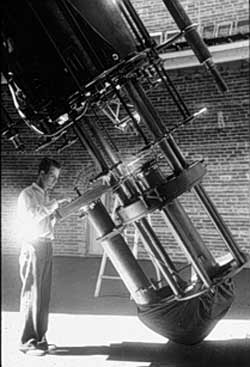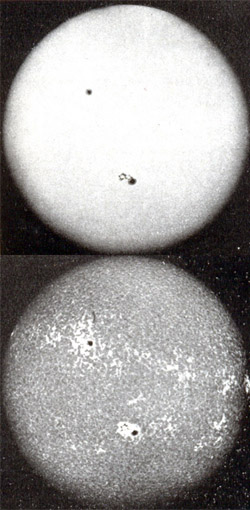
Sun-Earth Day Presents: Eclipse, In a Different Light
Astronomers study the sun by sorting its light and photographing its faintest details.
TECHNOLOGY THROUGH TIME ISSUE #38: GEORGE ELLERY HALE

A spectroheliograph mounted on the Yerkes Observatory 40-inch. (Courtesy: The University of Chicago)
George Ellery Hale (1868-1938) was an American astronomer interested in the evolution of the sun and stars. In the seven years after graduating from the Massachusetts Institute of Technology in 1890, he revolutionized solar observations with the invention of the spectroheliograph: an instrument that made it possible to photograph the Sun's prominences in full daylight. How would such an instrument work? It took a clever combination of two new technologies available to astronomers in the late-1800s: photography and spectroscopy.
Normally, the sun produces so much light that faint details on its surface are lost in the blinding glare of its light. A prism, however, spreads this ‘fire hose’ stream of light into a spectrum ordered by the wavelength of the light. A suitable instrument (a spectroscope) can be arranged to pass only a narrow band of wavelengths from this spectrum. The image of the sun from the telescope is scanned across a narrow slit. The light entering the slit is then passed through a spectroscope that is ‘tuned’ to a narrow band of wavelengths so that only light entering the slit within this spectral band will fall on a photographic film.

A spectroheliogram taken at Mount Wilson Observatory on July 30, 1906. (Top) Full-spectrum image in ‘white light’ showing two sunspots. (Bottom) Image obtained in ‘calcium light’. White areas have a higher temperature than darker areas.
The solar surface produces light at all wavelengths, which is why its surface is so blinding to see. But, heated gases produce light at only specific wavelengths. Astronomers can use a spectroheliograph to tune-in to specific gases such as hydrogen and calcium, and photograph solar details that are hot enough to emit the light from these elements. Because specific spectral lines require gases to exist at various temperatures from 2,000 to over 1 million C, astronomers can literally map the sun’s surface in terms of gases at different temperatures.
Within a few decades, Hale had revolutionized the way that astronomers study the sun. Instruments such as the spectroheliograph or based upon its principles, can now be found in most major observatories around the world â€" and on satellites in space.
Technology Through Time
ISSUES
- #46: The Magnetic Sun
- #45: Coronagraph
- #44: Einstein
- #43: Coronium
- #42: The Sun - In a Different Light
- #41: Gallery of Drawings
- #40: First Sun Photo
- #39: Solar Spectroscopy
- #38: George Ellery Hale
- #37: Coronal Mass Ejections
- #36: First Corona Descriptions
- #35: First Sunspot Drawing
- #34: Ptolemy
- #33: Ancient Greece
- #32: Ancient Babylon
- #31: Galileo Galilei
Eclipse Fact
There are at least 2 solar eclipses per year somewhere on the Earth.


